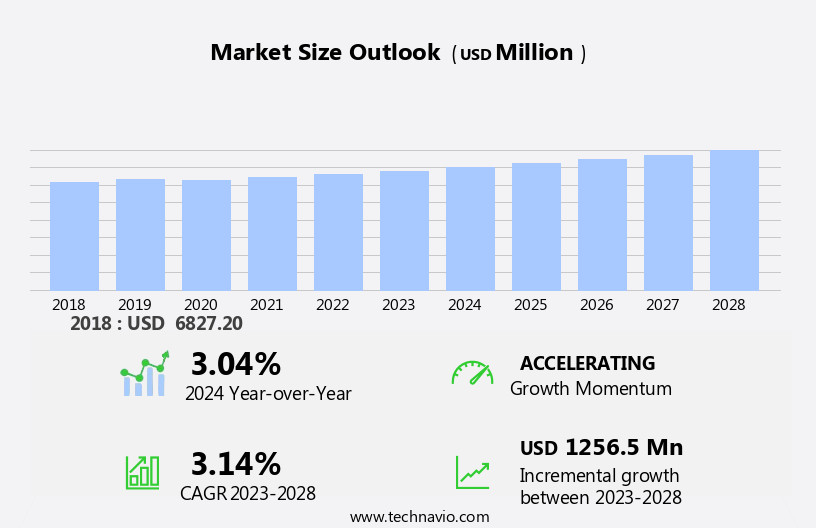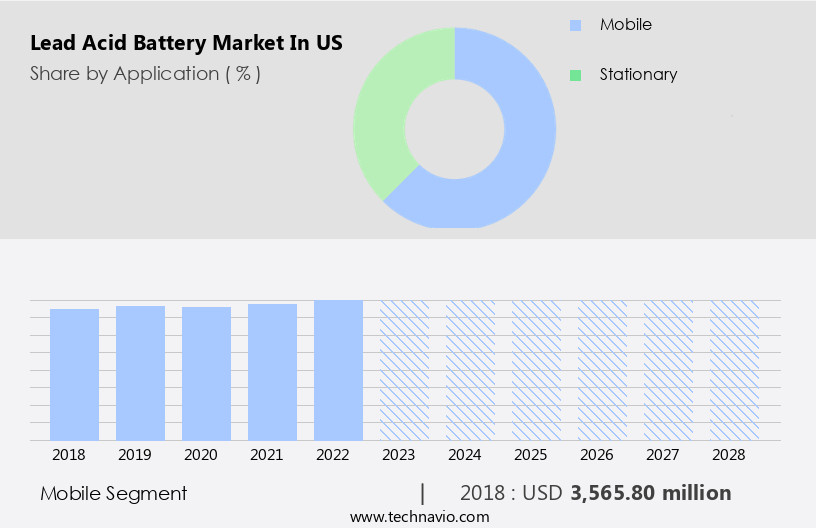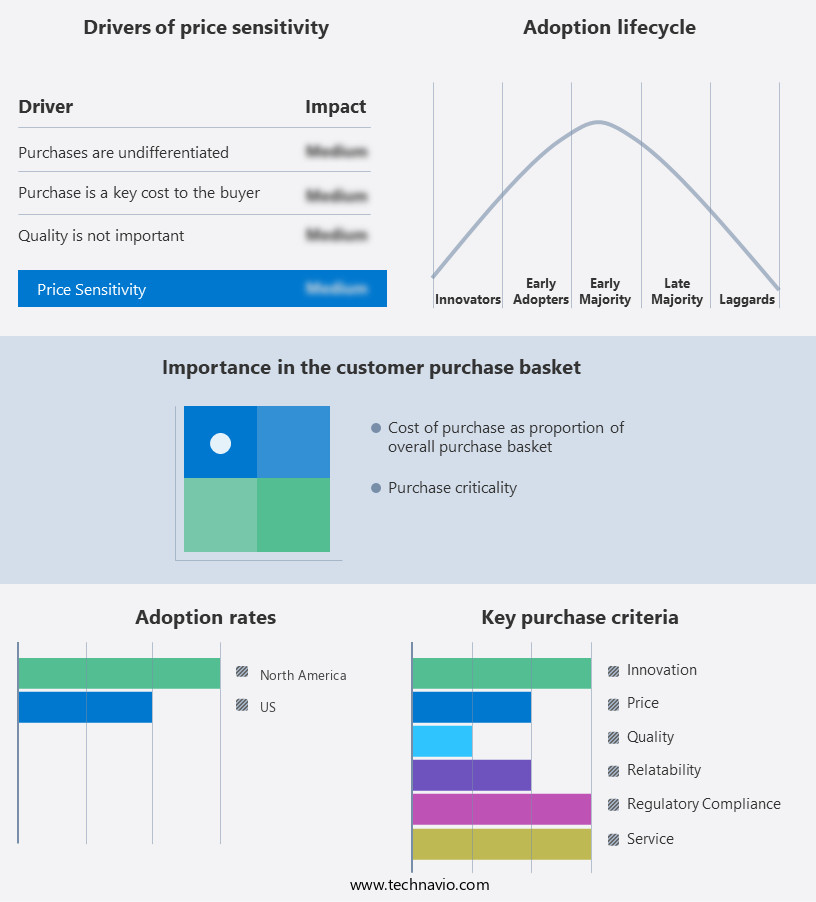US Lead Acid Battery Market Size 2024-2028
The US lead acid battery market size is forecast to increase by USD 1.26 billion at a CAGR of 3.14% between 2023 and 2028.
- In the market, the sector continues to witness significant growth due to the increasing focus on energy storage solutions for various applications. Key drivers include the expanding data center industry, which relies heavily on uninterrupted power supply, and the growing adoption of renewable energy sources, such as solar and wind, for power generation. Moreover, the demand for lead-acid batteries in microgrids and off-grid applications, including telecom equipment and lighting systems, is on the rise. The use of lead-acid batteries in niche applications, such as submarines and bioenergy, further bolsters market growth. Market trends include the declining costs of alternative batteries, such as lithium-ion, which may impact the market share of lead-acid batteries.
- However, advancements in lead-acid battery technology, including the use of lead oxide and nickel, and the integration of digital technologies, such as glass electrodes and sulfuric acid monitoring systems, offer opportunities for market growth. Additionally, the increasing demand for energy storage solutions in 5G services and greenhouse applications is expected to create new opportunities for market participants. Overall, the market is poised for steady growth, driven by the increasing demand for reliable energy storage solutions and the continuous advancements in battery technology.
What will be the size of the US Lead Acid Battery Market during the forecast period?

Request Free Sample
- The market encompasses the production and sale of lead acid batteries, a type of rechargeable battery widely used in various sectors, including telecommunications and energy storage. In the US market, this industry experiences significant demand due to the batteries' reliability and affordability. Lead acid batteries are integral to telecom sector applications, such as powering wireless telecom equipment and ensuring connectivity. Additionally, they are crucial in the military, data centers, and uninterruptible power supply (UPS) systems. Despite the prevalence of alternative technologies like lithium-ion and nickel-metal hydride batteries, lead acid batteries remain competitive. They consist of lead electrodes submerged in a sulfuric acid solution, with absorbent glass mat or gel VRLA batteries offering improved performance.
- Lead oxide and lead alloy plates are essential components. Water is added to maintain the battery's electrolyte level. Despite their advantages, lead acid batteries face challenges due to their toxic materials, including lead and sulfuric acid. However, advancements in battery design and recycling initiatives mitigate these concerns. The market's size and direction remain strong, driven by the growing need for energy storage devices in various applications and the continuous evolution of electronic equipment.
How is this market segmented and which is the largest segment?
The market research report provides comprehensive data (region-wise segment analysis), with forecasts and estimates in "USD million" for the period 2024-2028, as well as historical data from 2018-2022 for the following segments.
- Application
- Type
- Geography
By Application Insights
- The mobile segment is estimated to witness significant growth during the forecast period. The market spans various sectors, including telecom, energy storage, wireless telecom industry, military, data centers, and the IT sector. In the telecom industry, VRLA (Valve-Regulated Lead-Acid) batteries are utilized in telecom towers for backup power and connectivity. The energy storage space is another significant market for lead acid batteries, with applications in renewable energy, the electricity sector, and substations.
- The military sector uses lead acid batteries in UPS (Uninterruptible Power Supply) systems and vehicles. Lithium-ion technology and Nickel-Metal Hydride batteries are competitors, but lead acid batteries remain popular due to their cost-effectiveness and reliability. Original Equipment Manufacturers (OEMs) continue to use lead acid batteries in nickel-cadmium batteries, sealed lead-acid batteries, and absorbent glass mat batteries. The market is influenced by factors like automation, cranking power, cold-start capabilities, and backup power requirements.

Get a glance at the market share of various segments Request Free Sample
The Mobile segment was valued at USD 3.57 billion in 2018 and showed a gradual increase during the forecast period.
Market Dynamics
Our researchers analyzed the data with 2023 as the base year, along with the key drivers, trends, and challenges. A holistic analysis of drivers will help companies refine their marketing strategies to gain a competitive advantage.
What are the key market drivers leading to the rise in adoption of US Lead Acid Battery Market?
- Rising focus on green telecom towers is the key driver of the market. The sector is experiencing significant growth due to increasing mobile and smartphone penetration and declining telecom tariffs. This expansion has led to a rise in telecom subscriptions, resulting in the installation of numerous green telecom towers to reduce carbon footprint and greenhouse gas emissions. In response, lead acid battery manufacturers such as C&D Technologies INC, Clarios, and EnerSys are broadening their product offerings to include eco-friendly telecom power systems. The Energy storage space is crucial for the wireless telecom industry, as connectivity relies on uninterrupted power supply. Lead acid batteries, including Nickel-Metal Hydride, Nickel-cadmium, Absorbent Glass Mat, and Gel VRLA, are widely used due to their reliability and cost-effectiveness.
- New electrode designs, Calcium-alloy grids, Carbon additives, Pulse charging, and Multi-stage charging methods are enhancing the performance and longevity of these batteries. Additionally, the IT sector, data centers, UPS systems, and renewable energy sources like Solar, Wind, Hydropower, and Bioenergy require large-scale energy storage devices. Lead, Sulfuric acid, and other toxic materials are essential components of these batteries, necessitating proper disposal and recycling at recycling centers. The automotive sector, including passenger cars, e-bikes, and electric motors, also utilizes these batteries. The US military, marine commerce activities, and ICE vehicles also rely on these rechargeable batteries for backup power and cranking power, cold-start capabilities, and uninterruptible power supply systems.
What are the market trends shaping the US Lead Acid Battery Market?
- Rising company collaborations is the upcoming trend in the market. The lead acid battery market In the US is experiencing significant collaboration among companies and stakeholders to advance the technology and enhance its competitive edge against lithium-ion batteries. Pre-competitive research organizations, such as the Consortium for Battery Innovation (CBI), play a pivotal role in this endeavor. Comprised of lead acid battery manufacturers, raw material suppliers, technology suppliers, research institutions, and industry experts, these organizations facilitate research, technology development, and knowledge sharing. The market encompasses various segments, including the telecom sector, the Energy storage space in the wireless telecom industry, the military, data centers, and the IT sector. In the telecom industry, these batteries are utilized for uninterruptible power supply (UPS) systems, backup power, and cranking power for telecom towers and 5G services.
- The VRLA segment, which includes flooded batteries, absorbent glass mat, and gel VRLA batteries, dominates the market. New electrode designs, such as calcium-alloy grids and carbon additives, as well as charging methods like pulse charging and multi-stage charging, are being explored to improve lead acid battery performance. Automation and digitalization are also driving the market's growth. Lead acid batteries are used extensively in various industries, including the automotive sector, marine commerce activities, and the electricity sector, which relies on renewable energy sources like solar, wind, hydropower, and bioenergy. The market also includes various battery types, such as nickel-based batteries, zinc-based batteries, brand-new batteries, and rechargeable batteries, which are used in applications ranging from UPS systems to electric motors and passenger cars.
What challenges does US Lead Acid Battery Market face during the growth?
- Declining costs of lithium-ion batteries is a key challenge affecting the market growth. Lead acid batteries have traditionally held a significant market share in the energy storage space due to their cost-effectiveness and ability to deliver high bursts of instantaneous power, particularly in cranking applications for automobiles. However, lithium-ion batteries are gaining popularity due to their superior performance characteristics, such as higher current density, longer power-holding capacity, and longer shelf life. The cost gap between these battery chemistries has narrowed substantially over the past decade, driven by increased production scale and manufacturing efficiency. In the telecom sector, including the wireless telecom industry, connectivity and backup power are crucial. Lead acid batteries, specifically valve-regulated lead-acid (VRLA) batteries, are widely used in telecom applications for their reliability and ability to provide backup power in the event of grid failures.
- In data centers, uninterruptible power supply (UPS) systems rely on lead acid batteries to ensure continuous power supply. Lithium-ion batteries, on the other hand, are increasingly being adopted for their longer cycle life, higher energy density, and faster charging capabilities. In the IT sector, lithium-ion batteries are used in servers to provide backup power during power outages and to support the increasing internet traffic. Both lead acid and lithium-ion batteries have their unique advantages and applications. While these batteries offer cost-effectiveness and reliability, lithium-ion batteries provide superior performance and longer life. The energy storage market is witnessing a shift towards lithium-ion batteries, driven by advancements in technology and declining costs The energy storage market is evolving rapidly, driven by digitalization, the increasing demand for 5G services, and the growing subscriber base for telecom services. In marine commerce activities, lead acid batteries are used in electric motors and forklift trucks.
Exclusive US Lead Acid Battery Market Customer Landscape
The market forecasting report includes the adoption lifecycle of the market, covering from the innovator's stage to the laggard's stage. It focuses on adoption rates in different regions based on penetration. Furthermore, the report also includes key purchase criteria and drivers of price sensitivity to help companies evaluate and develop their market growth analysis strategies.

Customer Landscape
Key Companies & Market Insights
Companies are implementing various strategies, such as strategic alliances, market forecast partnerships, mergers and acquisitions, geographical expansion, and product/service launches, to enhance their presence in the market.
The market research and growth report includes detailed analyses of the competitive landscape of the market and information about key companies, including:
- C and D Technologies Inc.
- Camel Group Co. Ltd.
- CLARIOS LLC
- Concorde Battery Corp.
- Crown Equipment Corp.
- East Penn Manufacturing Co. Inc.
- Energizer Holdings Inc.
- EnerSys
- Exponential Power Inc.
- HBL Power Systems Ltd.
- Johnson Controls International Plc.
- Panasonic Holdings Corp.
- Power Sonic Corp.
- Robert Bosch GmbH
- Surrette Battery Co. Ltd.
- Teledyne Technologies Inc.
- Trojan Battery Co. LLC
- U.S. Battery Manufacturing Co.
- UPS Battery Center Ltd.
- Wirtz Mfg Co. Inc.
Qualitative and quantitative analysis of companies has been conducted to help clients understand the wider business environment as well as the strengths and weaknesses of key market players. Data is qualitatively analyzed to categorize companies as pure play, category-focused, industry-focused, and diversified; it is quantitatively analyzed to categorize companies as dominant, leading, strong, tentative, and weak.
Research Analyst Overview
The market encompasses a broad scope of applications including the energy storage sector. This technology plays a crucial role in various industries, including telecommunications and the energy sector. In the telecommunications industry, these batteries are utilized to power electronic equipment and provide backup power for telecom towers and UPS systems. The energy storage space is a dynamic and evolving market, driven by the increasing demand for connectivity and renewable energy. These batteries, specifically valve-regulated lead-acid (VRLA) batteries, have been a mainstay in this sector due to their reliability, durability, and cost-effectiveness. The wireless telecom industry relies heavily on these batteries to power base stations and provide backup power for critical communication networks.
In addition, lead acid batteries are used in the military for various applications, including powering electronic equipment and providing backup power for critical systems. Data centers and IT sectors also utilize these batteries for backup power and to ensure uninterrupted power supply for servers and internet traffic. The VRLA segment, specifically, has gained popularity due to its maintenance-free design and long service life. These batteries are also used in the electricity sector for various applications, such as grid energy storage and in substations. In the renewable energy sector, lead acid batteries are used to store excess energy generated from solar, wind, hydropower, bioenergy, and other sources.
Moreover, the market is driven by several factors, including the increasing demand for energy storage devices, the growing use of electronic equipment, and the need for backup power in various industries. New electrode designs, such as calcium-alloy grids and carbon additives, are being developed to improve the performance and efficiency of lead acid batteries. Automation and advanced charging methods, such as pulse charging and multi-stage charging methods, are also being adopted to optimize the performance and lifespan of lead acid batteries. The market is expected to continue growing due to the increasing demand for renewable energy and the need for reliable and cost-effective energy storage solutions.
|
Market Scope
|
|
Report Coverage
|
Details
|
|
Page number
|
133
|
|
Base year
|
2023
|
|
Historic period
|
2018-2022 |
|
Forecast period
|
2024-2028
|
|
Growth momentum & CAGR
|
Accelerate at a CAGR of 3.14%
|
|
Market growth 2024-2028
|
USD 1.26 billion
|
|
Market structure
|
Fragmented
|
|
YoY growth 2023-2024(%)
|
3.04
|
|
Competitive landscape
|
Leading Companies, Market Positioning of Companies, Competitive Strategies, and Industry Risks
|
Request Free Sample
What are the Key Data Covered in this Market Research Report?
- CAGR of the market during the forecast period
- Detailed information on factors that will drive the market growth and forecasting between 2024 and 2028
- Precise estimation of the size of the market and its contribution of the market in focus to the parent market
- Accurate predictions about upcoming market growth and trends and changes in consumer behaviour
- Growth of the market across US
- Thorough analysis of the market's competitive landscape and detailed information about companies
- Comprehensive analysis of factors that will challenge the growth of market companies
We can help! Our analysts can customize this market research report to meet your requirements Get in touch
Research Framework
Technavio presents a detailed picture of the market by way of study, synthesis, and summation of data from multiple sources. The analysts have presented the various facets of the market with a particular focus on identifying the key industry influencers. The data thus presented is comprehensive, reliable, and the result of extensive research, both primary and secondary.
 INFORMATION SOURCES
INFORMATION SOURCES
Primary sources
- Manufacturers and suppliers
- Channel partners
- Industry experts
- Strategic decision makers
Secondary sources
- Industry journals and periodicals
- Government data
- Financial reports of key industry players
- Historical data
- Press releases

 DATA ANALYSIS
DATA ANALYSIS
Data Synthesis
- Collation of data
- Estimation of key figures
- Analysis of derived insights
Data Validation
- Triangulation with data models
- Reference against proprietary databases
- Corroboration with industry experts

 REPORT WRITING
REPORT WRITING
Qualitative
- Market drivers
- Market challenges
- Market trends
- Five forces analysis
Quantitative
- Market size and forecast
- Market segmentation
- Geographical insights
- Competitive landscape







![]() Get the report (PDF) sent to your email within minutes.
Get the report (PDF) sent to your email within minutes.
Complimentary full Excel data with your report purchase.